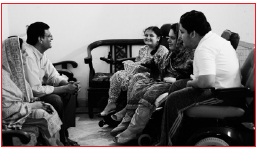The Forgotten Five: A Story of Courage
By Shaila Abdullah
Austin, TX

When you are dealing with a rare genetic disorder, options and solutions are also rare and hard to find. Read the story of a father in Pakistan desperate to find a cure for his three children who suffer from a progressive neuromuscular disorder.
Despite the hand life has dealt him, Shahid Zubair, 44, of Lahore, Pakistan, has three pressing reasons to get up each day.
They are his three children—Nida, 16; Ahmed, 14; and Eman, 9—who each have a rare genetic disorder called muscular dystrophy (MD) that requires the use of a wheelchair.
“I feel like I am living a nightmare,” says the heartbroken father of three. “Hoping that I might wake up any moment and my children would be healthy and whole again, playing outside, riding their bikes, their laughter filling the air.”
As any child should.
The Stressors
An added stress to the household is the grim reality that Shahid, the only earning member of the household, lost his job last year as a logistics manager at a local supply chain in Lahore.
The Zubairs are under no illusions. They are well aware that most doctors simply suggest a management plan for patients suffering from MD.
“I was told that there is no known cure for what my children have,” says Zubair. “It is something no parent wants to hear.”
Shahid scoured the Web and other resources at his disposal to look for solutions. What he discovered seems hopeful but beyond his reach.
“There are clinical trials and some preliminary treatment options underway in the US and other countries that can help manage the condition better, but they seem to all be beyond my reach and means.”
Getting the Right Kind of Help
The term muscular dystrophy refers to a group of 30 genetic diseases characterized by progressive weakness and degeneration of the skeletal muscles that control movement.
“I refuse to accept that death sentence for my children,” says Shahid.
A donor helped build a website for the Zubair children at www.miracleforthree.com and started a series of Indiegogo campaigns to help the family. But in the end, all the efforts resulted in the family raising merely $2,535, which helped fund an electric wheelchair for their youngest daughter Eman.
The Three Targets
The initial encounter with muscular dystrophy for Shahid and his wife, Saher, came suddenly when their oldest daughter, Nida, turned 7. By then, the Zubairs had added two more children to their family, not knowing that the disease was lurking in their genetic makeup.
Nida had experienced a healthy and uneventful childhood before that fateful day in 2005. The high fever was accompanied by chest congestion. After being admitted to a hospital and receiving antibiotics intravenously for five days, Nida’s fever finally settled. Back at home, the usually active child began to experience difficulty in climbing stairs. A battery of tests confirmed a parent’s worst nightmare—Nida had muscular dystrophy.
She gradually lost her ability to walk due to muscular weakness and became confined to a wheelchair.
In the midst of that stress, the disease chose its next target—Ahmed. For an odd reason, the condition remains dormant in the Zubair children until they reach the age of 7. Ahmed, a rambunctious child, complained of abdominal pain and landed in the hospital with high fever. Within days, he started to have leg pain and received the MD diagnosis.
The frightened parents rushed to get their youngest daughter evaluated. The test confirmed their worst fears. Eman too had muscular dystrophy. She soon joined her siblings in needing to use a wheelchair.
By then, Nida had developed scoliosis of spine and was unable to eat or drink by herself.
Everyday Struggles
The Zubair household is in full swing by 8 am after a night of helping the children change positions frequently to keep bedsores from developing. In the morning hours, Shahid assists Saher in tending to the children before dashing out to the last few days of work at his job.
“We finally invested in electric wheelchairs to allow the children more mobility,” says Shahid. “Even then, extended sitting, frequent power outages, and extreme heat makes sitting extremely difficult for the children at times.”
During the day, the children try to have some semblance of normalcy in between their daily doses of Western and holistic medications, as well as physical therapy administered by their parents. A tutor visits the children during the evenings a few times a week to teach for a modest fee.
“My children are a gift from God,” says Saher. “When I see them, I see beauty, I see hope, I feel love. They are my life. When I break down, they give me courage.”
The Zubair family continues to hope and pray for a miracle that might one day show up on their doorstep and this summer their prayers were finally answered. Shahid found out that all three of his children had been accepted for evaluation and possible inclusion for a stem cell research study at UCLA. A donor also agreed to pay for a major portion of Nida's scoliosis surgery. The family is arriving in October and still needs funds for ongoing treatment and logistics. To find out how you can offer assistance to the Zubair family, please visit http://miracleforthree.com/how-you-can-help/
(Shaila Abdullah is an award-winning author, writer, and designer in Austin, Texas. She has written five books: Saffron Dreams, Beyond the Cayenne Wall, A Manual for Marco, Rani in Search of a Rainbow, and My Friend Suhana. Saffron Dreams is taught in major universities such as University of California, the University of Nebraska-Lincoln, Indiana University, and Boston University. An excerpt of Saffron Dreams was used as a basis for a research study on racism conducted by Washington and Less University researchers Her work primarily focuses on disadvantaged individuals and groups)

